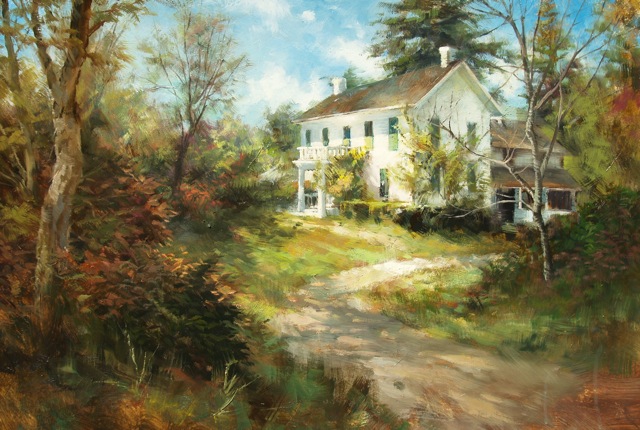“Hanley Farm House” by Stefan Baumann
The painting I am sharing with you today is of the family home on the Hanley Farm located outside of Medford, Oregon. It is a place I recently discovered when I was looking for a location for a plein air workshop. When I saw the Hanley family home, it spoke to me about the feeling of being left alone after years of love. Painting a “feeling” is the highest form of expression because it reveals the heart of the artist. Most paintings are of things such as trees, rocks, a vase, a river, or buildings. An artist can change the effect of light or the composition in a painting to make it more compelling and interesting, but a “feeling” is what the great masters were trying to capture.
A student recently asked me, “How do I critique my own painting? What should I look for, and what do you see when you critique paintings?” Critiques are difficult to receive and endure for most artists. Artists generally do not like to hear what works and what is missing in their paintings. However, like all disciplines, we must learn from others. What others think is important if you want to create powerful paintings that speak to the viewing public.
In my 12-week Power to Create course, I spend 3 hours each week critiquing the students’ artwork painted as assigned homework for the week. After a several weeks of participating in the critiques, students in the class begin to understand how to look objectively at their paintings and the paintings of others. Here are the top five elements that I look for when I critique a painting. As you read the information below, look at one of your paintings and follow along, asking yourself these questions.
1. Message: The first thing I ask is “what were you trying to say with the painting?”
to confirm whether I got the idea or not. If the message is not clear to the
artist, how will the viewer be able to understand what the artist is trying to
communicate? In addition, is the focal point clearly identifiable, does it support
the message, and does it draw the viewer into the painting?
2. Composition: I look to see if the composition in the painting attracts the viewer’s
attention, directs the viewer’s eye to the important areas of the painting, and
keeps the viewer’s interest involved in the painting. The composition must be
simple regardless of the size of painting. Composition is merely an element of
the total effort, and must remain subordinate to the representation of the
subject and message.
3. Value: I determine whether there is an adequate variety of value intensities. The value is the degree of the darkness in contrast to the lightness of a color on
a scale from white to black. By squinting, I make sure that the painting has
clear and identifiable value changes.
4. Edges: Are there a variety of brush strokes and edges defining the distance of
objects and content in the painting? Soft edges are found on the sides and in
the background of the painting, while crisp and sharp edges are seen near the
focal point and on objects as they get closer to the foreground of a painting.
5. Light Source: I am surprised that many paintings are missing a defined light
source that indicates the direction the light is coming from. When painting
outdoors, an artist must choose a source of light and keep it in place, to prevent
the mistake of “chasing the light” as it changes with time, causing the painting
to become flat.
Of course, there are many more key elements, but these will help you to look more objectively at your paintings. We will discuss all of these topics and many more during our Fall Workshops. I invite you to attend a weekend in Mt. Shasta that will inspire you and change the way you paint forever.
_____________________________________________
Plein air and Alla Prima artist Stefan Baumann host of the PBS painting series The Grand View, American National Park through the eyes of an artist” and author of “Observations Of Nature” and “Everything you need to know about Plein Air Painting”, travels in his vintage travel trailer painting Americas western landscape. Painting outdoors he recreates in oil stunning vistas in his studio of wildlife, western, landscapes, portraits and still life on canvas thrilling art collectors throughout the world and has many collectors acquiring his painting’s as investment internationally. His Paintings style is called Romantic Luminism Realism, It’s truly an American Style of depicting the Western Landscape. He can be seen painting in Yellowstone, Yosemite and the Grand Canyon and his how to paint DVD’s of Baumann filmed on location in the National Parks are the very best on the market.

